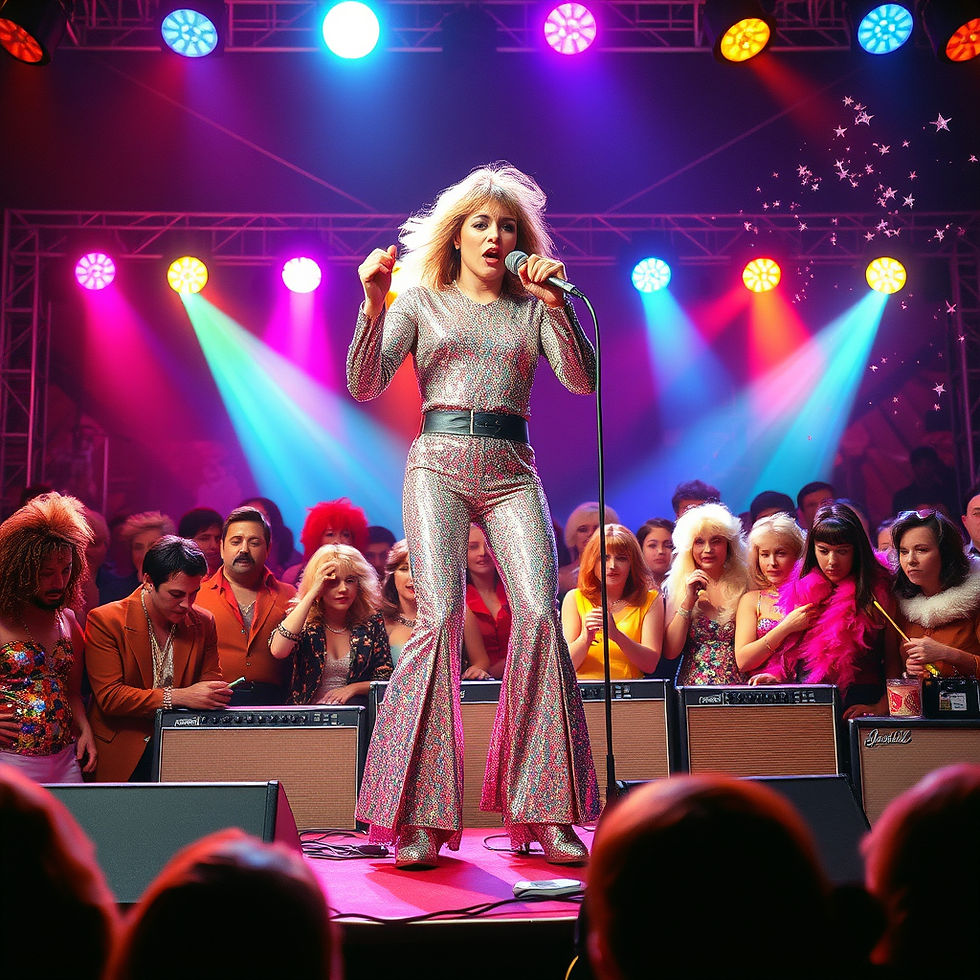
Photo- AI Generated
Glam Rock: Sparkle, Glitter, and Excess
Glam Rock, which emerged in the early 1970s, erupted on the scene with flamboyance, revolt, and dramatic flare.
8 July 2025
The 1970s were a decade of extremes, with political unrest, space-age fantasies, and a burgeoning counterculture that demanded to be seen and heard. Amidst this altering cultural milieu, a genre evolved that was so loud, showy, and unabashedly daring that it revolutionised what it meant to be a rock star. This was Glam Rock—a brilliant clash of heavy riffs, extravagant clothes, and androgynous theatrics that not only questioned conventional standards but also elevated dissent to the status of glitter-coated art.
Glam rock, which originated in the United Kingdom in the early 1970s, was more than simply music; it was also about the show. At the same time, the music merged pop melodies with the energy of hard rock. What distinguished glam was its appearance: sparkling jumpsuits, sky-high platform boots, dramatic makeup, feather boas, and gender-bending aesthetics. This was music intended to be seen as well as heard.
David Bowie led the effort, creating one of music's most legendary characters, Ziggy Stardust. Bowie's alien alter persona Ziggy combined science fiction and sexual emancipation, allowing him to explore identity, celebrity, and loneliness. His 1972 album, The Rise and Fall of Ziggy Stardust and the Spiders from Mars, was more than just a concept album; it was a manifesto for the misunderstood, misfit, and brave.
T. Rex's leader, Marc Bolan, helped popularise glam rock. Bolan's smashes, "Get It On (Bang a Gong)" and "20th Century Boy," added swagger and sparkle to bluesy rock beats. His impact reverberated across the scene, inspiring a wave of acts such as Slade, Sweet, Mott the Hoople, and Roxy Music, each adding their twist to glam's dazzling concoction.
Glam rock's music was deceptively simple—built on uncomplicated chord progressions, irresistible choruses, and stomping rhythms—but it was wrapped in the maximalist aesthetics of camp, kitsch, and defiance. Songs like "Ballroom Blitz," "Cum On Feel the Noize," and "Virginia Plain" filled venues and rocked conservative audiences. Glam was loud in every meaning of the word.
Glam rock was more than just a musical statement; it was also a societal one. In a world still grappling with postwar conservatism and antiquated ideals of masculinity, glam provided a radical alternative. It blurred gender lines, challenged fashion rules, and accepted artifice as authentic. It was both genuine and ironic, attacking celebrity culture while also embracing it.
The media wasn't sure what to do with it. Parents panicked. Politicians disregarded it. But children in bedrooms around the world saw something new, something liberating. For a while, you didn't have to fit in; all you had to do was shine.
Glam rock has a far-reaching influence beyond the United Kingdom. Across the Atlantic, American artists such as Alice Cooper and the New York Dolls embraced the glam look, combining it with shock rock and proto-punk energy. Their gigs evolved into chaotic, glitter-drenched productions that combined theatre and musical protest.
By the mid-1970s, glam had faded, replaced by the raw violence of punk and the slickness of disco. Nonetheless, its effect persisted. Without glam rock, there is no punk. No hair metal. No Lady Gaga. There's no Harry Styles in a Gucci outfit. Glam made it acceptable to be loud, unconventional, and unabashedly expressive. It challenged rock's macho image and infused performance with lyricism.
Glam rock is now recognised as a mentality more than a genre—one that dared to turn up the volume, paint the town fluorescent, and redefine cool in platforms and eyeliner. Whether you're listening to T. Rex on vinyl or revisiting Bowie's Aladdin Sane, glam is a glittering reminder that rock 'n' roll is more than simply revolt; it's also about reinvention.









